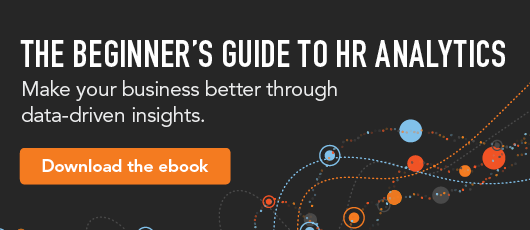
.png?width=450&name=Building%20a-People-Analytics-Strategy-A-Guide%20(1).png) For years, HR leaders have faced barriers toward making strategic, evidence-based business decisions with people analytics. But often, it’s to no fault of their own—many HR professionals don’t have the right tools to collect, analyze, and interpret their people analytics data.
For years, HR leaders have faced barriers toward making strategic, evidence-based business decisions with people analytics. But often, it’s to no fault of their own—many HR professionals don’t have the right tools to collect, analyze, and interpret their people analytics data.
Due to the current nature of the workplace, you can’t risk making decisions about your people that aren’t informed by data. That’s why every forward-thinking, growth-oriented leader needs to adopt a people analytics strategy that works.
![[FREE DOWNLOAD] The Beginner's Guide to HR Analytics: The What, Why, and How of HR Analytics](https://no-cache.hubspot.com/cta/default/99128/3dfd3ec6-e9d8-4d30-99e3-4305a6021275.png)
People analytics is the collection and application of people and business data to important business decisions. With a strong people analytics strategy, you can uncover deep insights about your talent to make better business decisions. Insights that help you attract and retain top talent, boost engagement, and motivate performance.
It’s important to understand where your people analytics data comes from and how it connects to business success. Talent data is typically collected through:
And when you connect these data points to business outcome data, you can make strategic, evidence-based people decisions. Common business outcome data includes:
From demographics and diversity to productivity and performance, people analytics can help you answer the questions that you need to know about your workforce. Here are some examples of common questions that people analytics can help answer:
Building an effective people analytics strategy can seem intimidating. But when you leverage the right process, you’ll uncover key insights that are critical to strategic decision making. Here’s how forward-thinking business leaders are shaping their people analytics strategy.
For your people analytics strategy to be worthwhile, you have to outline what realistic business goals you want to achieve. Without a business problem that needs solving or an opportunity that you want to uncover, your resources will go to waste.
A people analytics strategy can have a huge impact on retention, employee engagement, productivity, and hiring. And if you struggle in any of these areas, people analytics can serve as a tool to uncover insight, discover opportunities, and prompt the right action toward your goals.
Leaders need to create clarity around their data sources. Without clear, effective sources, you simply won’t be able to uncover the insights that you need. Luckily, once you understand which data sources are available, you’re on the right path toward discovering valuable employee insight. But until you assess and eliminate your data gaps, your insights won’t be complete.
Data gaps happen when you don’t gather the full scope of employee information. These gaps are all about the data that you don’t have, but hope to collect. When you only focus on the data you do have, it’s easy to miss out on opportunities. That’s why leveraging many types of data sources helps you avoid data gaps and capture comprehensive insight about your people.
The right technology can streamline and support your people analytics strategy. When you have little experience collecting, analyzing, and interpreting data, your data integrity can suffer and your findings will be less reliable. Plus, without the ability to connect your data to business outcomes and take the right action, your data is useless.
That’s why successful leaders are leveraging a people analytics platform that helps them gather, understand, and take action on their people data. In fact, high performing organizations are 2x more likely to use people analytics software than low performing organizations.
The right software will offer a suite of tools that help accelerate your business goals. Your platform should take administrative burden off of your teams, frequently monitor trends, and help you put your findings into practice in a more timely and effective way.
To collect data, you first have to outline which metrics and KPIs you want to track. You should leverage data engineers and data scientists that have experience collecting and tracking quality data. Once you’ve shaped your analytics team, they can compile collected data in a process called integration. In this process, raw data is derived from your findings and constructed in a format that’s easy to interpret. This way, you can see important trends at-a-glance.
Visualizing your data is important. After it’s integrated, you can pinpoint employee patterns and trends that affect your business. You should be able to examine your data all in one place, seamlessly.
The ability to splice and dice data between different demographic groups should be at your fingertips to uncover deeper trends about your workforce. Your data experts should help you interpret and understand the full scope of these existing trends so that you can connect them to important business data.
After you’ve uncovered relevant trends, it’s time to create and implement a strategy. Bring your leadership teams into the conversation and clearly communicate how your findings support your solutions. The outcomes of your action plan should be clear-cut, direct, and logical to ensure the plans are adopted and contributed to by all. With the right data, insights, and action plan, you can tackle unique business problems and get serious about the opportunities that are essential to success.
Ready to build a people analytics strategy that works for your business? Download The Beginner's Guide to HR Analytics and get the insight you need to move forward with confidence.
Published February 22, 2022 | Written By Elise Paulsen